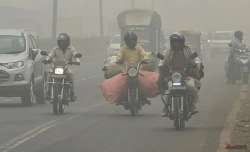Revamped plan to check air pollution in Delhi-NCR to come into force from October 1
The revised plan, which is part of a new policy formulated by the CAQM to abate air pollution in Delhi-NCR, focuses on the proactive implementation of curbs based on forecasts, and restrictions can be imposed up to three days in advance.

The revamped Graded Response Action Plan -- a set of anti-air pollution measures followed in Delhi and its vicinity according to the severity of the situation -- will come into force from October 1; 15 days before the usual date, according to the Commission for Air Quality Management.
The revised plan, which is part of a new policy formulated by the CAQM to abate air pollution in Delhi-NCR, focuses on proactive implementation of curbs based on forecasts and restrictions can be imposed up to three days in advance. Earlier, the authorities would implement the measures only after the PM2.5 and PM10 concentration touched a particular threshold.
The new plan also entails a ban on BS IV four-wheeler diesel vehicles, barring those engaged in essential services, in Delhi and the bordering districts of NCR if the air quality index (AQI) breaches the 450 mark.
The Graded Response Action Plan (GRAP), notified by the Ministry of Environment and Forests in 2017, would come into force from October 15 when air pollution levels in the region start worsening. The CAQM has now decided to implement it from October 1, according to a communication sent to state agencies and departments concerned.
The GRAP for the National Capital Region (NCR) has now been classified under four different stages of adverse air quality in Delhi: Stage I - 'Poor' (AQI 201-300); Stage II - 'Very Poor' (AQI 301-400); Stage III - 'Severe' (AQI 401-450); and Stage IV - 'Severe Plus' (AQI >450).
The revised GRAP recommends a ban on the use of coal and firewood, including in tandoors in hotels, restaurants, open eateries; and on diesel generator sets, except for emergent and essential services under Stage I.
If the situation turns "severe" (Stage III), authorities will have to enforce a ban on construction and demolition activities in NCR, except on essential projects (like railways, metros, airports, ISBTs, national security/defence-related projects of national importance) and non-polluting activities such as plumbing, carpentry, interior decoration and electrical works.
Also Read | Indian airlines Akasa Air's first flight takes off from Mumbai, Scindia launches operations
Brick kilns, hot mix plants and stone crushers not operating on clean fuels, and mining and associated activities in NCR will also be banned under Stage III. "State governments in Delhi-NCR may impose restrictions on BS III petrol and BS IV diesel light motor vehicles (four wheelers) under Stage III," the policy document read.
The measures to be followed in the "Severe Plus" category or Stage IV include a ban on the entry of trucks into Delhi, and on the plying of Delhi-registered diesel-run medium goods vehicles and heavy goods vehicles (HGVs) in the national capital except those carrying essential commodities.
The use of four-wheeler diesel light motor vehicles, except for BS-VI vehicles and vehicles engaged in essential services, will also be banned in Delhi and the bordering districts of NCR.
Stage IV will also entail a ban on industries running on dirty fuels and on construction and demolition activities in linear public projects such as highways, roads, flyovers, over bridges, power transmission and pipelines.
"State governments can consider allowing 50 per cent staff to work from home in public, municipal and private offices, and additional emergency measures like closure of educational institutions and the plying of vehicles on odd-even basis etc," it said.
Actions under Stages II, III and IV will have to be taken at least three days in advance of the air quality index (AQI) reaching to the projected levels of that stage. Earlier, authorities would wait until PM 2.5 or PM 10 concentration touched a particular threshold.
Under the 'severe plus' category, agencies waited for PM 2.5 and PM 10 concentrations to stay above 300 and 500 micrograms per cubic metre for 48 hours or more before implementing the measures mandated under GRAP.
The sub-committee on GRAP will meet frequently to plan for advance action and issue necessary orders for invoking various provisions of GRAP, based on the prevalent air quality and the AQI forecast to be provided by the India Meteorological Department (IMD) from time to time.
Also Read | Lumpy skin disease on surge in Rajasthan; locals cautioned against drinking affected cows' milk